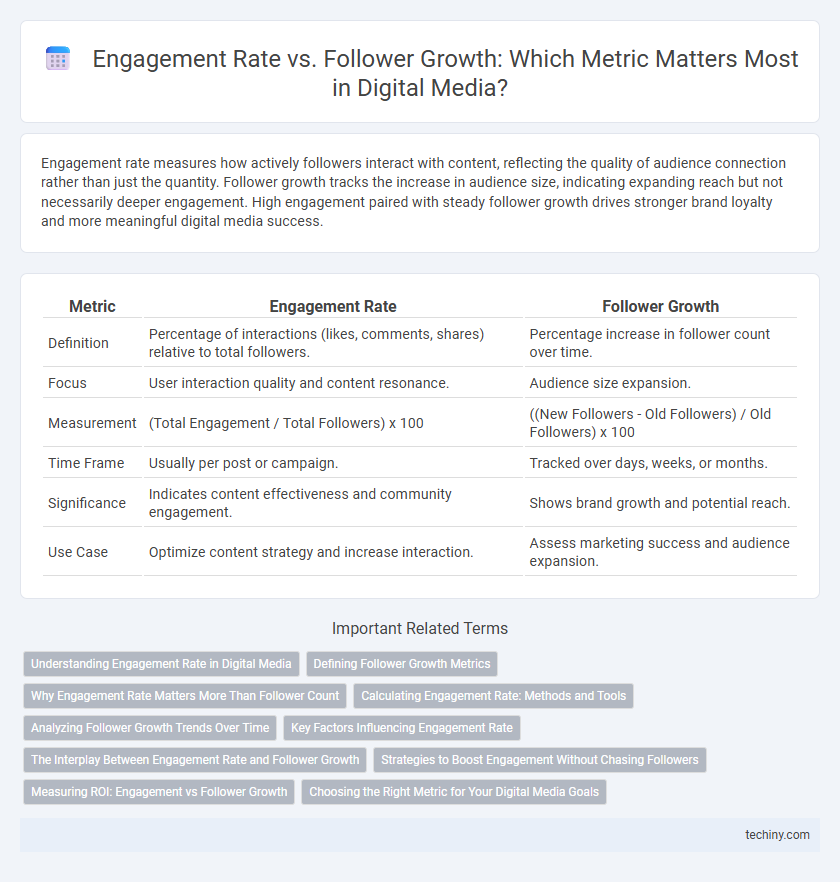Engagement rate measures how actively followers interact with content, reflecting the quality of audience connection rather than just the quantity. Follower growth tracks the increase in audience size, indicating expanding reach but not necessarily deeper engagement. High engagement paired with steady follower growth drives stronger brand loyalty and more meaningful digital media success.
Table of Comparison
| Metric | Engagement Rate | Follower Growth |
|---|---|---|
| Definition | Percentage of interactions (likes, comments, shares) relative to total followers. | Percentage increase in follower count over time. |
| Focus | User interaction quality and content resonance. | Audience size expansion. |
| Measurement | (Total Engagement / Total Followers) x 100 | ((New Followers - Old Followers) / Old Followers) x 100 |
| Time Frame | Usually per post or campaign. | Tracked over days, weeks, or months. |
| Significance | Indicates content effectiveness and community engagement. | Shows brand growth and potential reach. |
| Use Case | Optimize content strategy and increase interaction. | Assess marketing success and audience expansion. |
Understanding Engagement Rate in Digital Media
Engagement rate in digital media measures the level of interaction--likes, comments, shares--relative to the total number of followers, providing a clear metric of audience engagement quality. Understanding this rate helps marketers optimize content strategies by identifying which posts resonate most effectively with their target audience. A high engagement rate often indicates a loyal and active community, which can be more valuable than simply increasing follower growth without meaningful interactions.
Defining Follower Growth Metrics
Follower growth metrics measure the increase in the number of followers on digital media platforms over a specific period, reflecting audience expansion and reach potential. These metrics include net follower gain, follower growth rate percentage, and monthly active follower increments, providing key insights for content strategy optimization. Tracking follower growth alongside engagement rate helps balance quantity with quality of interactions, ensuring sustainable digital media marketing success.
Why Engagement Rate Matters More Than Follower Count
Engagement rate measures the quality of interactions between content and audience, reflecting true follower interest and brand loyalty, whereas follower count only indicates potential reach without guaranteeing active participation. High engagement rates boost content visibility through platform algorithms, leading to organic growth and better return on investment. Brands focusing on engagement can foster meaningful relationships, increase conversion rates, and sustain long-term digital presence more effectively than merely accumulating followers.
Calculating Engagement Rate: Methods and Tools
Calculating engagement rate involves dividing the total interactions--likes, comments, shares--by the total number of followers or impressions, then multiplying by 100 to get a percentage. Tools like Sprout Social, Hootsuite Analytics, and Buffer provide automated engagement rate calculations with insights into audience behavior and content performance. Accurate engagement metrics help digital marketers optimize campaigns by identifying high-performing posts and understanding follower interaction trends.
Analyzing Follower Growth Trends Over Time
Analyzing follower growth trends over time reveals critical insights into audience behavior and content effectiveness within digital media strategies. Tracking fluctuations in follower count helps identify periods of rapid expansion or decline, directly correlating with content campaigns, platform algorithm changes, or industry events. Engagement rate metrics complement this analysis by showing how actively followers interact, providing a holistic view of both quantity and quality in audience development.
Key Factors Influencing Engagement Rate
Engagement rate in digital media is primarily influenced by content relevance, posting frequency, and audience interaction quality. High-quality, targeted content paired with consistent posting schedules boosts user participation and retention. Algorithms favor active engagement metrics, which directly impact the visibility and growth trajectory of a digital media profile's follower base.
The Interplay Between Engagement Rate and Follower Growth
Engagement rate and follower growth are key metrics in digital media, each revealing different aspects of audience interaction and brand reach. A high engagement rate often signals strong content resonance, which can drive organic follower growth by encouraging shares and recommendations. Conversely, rapid follower growth without corresponding engagement may indicate low-quality followers or diminishing content relevance, highlighting the importance of balancing both metrics for sustainable digital success.
Strategies to Boost Engagement Without Chasing Followers
Focusing on content quality and audience interaction significantly boosts engagement rates without relying solely on follower growth. Implementing personalized responses, interactive polls, and authentic storytelling encourages deeper connections and sustained user involvement. Prioritizing genuine engagement metrics over follower count leads to a more loyal and active digital media community.
Measuring ROI: Engagement vs Follower Growth
Measuring ROI in digital media requires analyzing engagement rate alongside follower growth to determine true audience interaction and brand impact. Engagement rate reflects how actively followers interact with content, providing immediate insights into content effectiveness, while follower growth indicates potential reach and brand awareness expansion. Balancing both metrics enables marketers to optimize strategies for sustained audience loyalty and higher conversion rates.
Choosing the Right Metric for Your Digital Media Goals
Engagement rate measures the level of audience interaction through likes, comments, and shares, providing insight into content effectiveness and community loyalty. Follower growth tracks the increase in audience size, reflecting brand reach expansion and long-term potential. Selecting the right metric depends on digital media goals, with engagement rate favoring content quality and follower growth emphasizing audience acquisition strategies.
Engagement Rate vs Follower Growth Infographic

 techiny.com
techiny.com